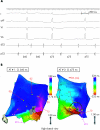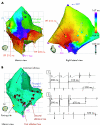Dual-loop circuits in postoperative atrial macro re-entrant tachycardias
- PMID: 16980513
- PMCID: PMC1861432
- DOI: 10.1136/hrt.2006.094748
Dual-loop circuits in postoperative atrial macro re-entrant tachycardias
Abstract
Background: Patients may develop dual-loop re-entrant atrial arrhythmias late after open-heart surgery, and mapping and catheter ablation remain challenging despite computer-assisted mapping techniques.
Objectives: The purpose of the study was to demonstrate the prevalence and characteristics of dual-loop re-entrant arrhythmias, and to define the optimal mapping and ablation strategy.
Methods: 40 consecutive patients (mean (SD) age 52 (12) years) with intra-atrial re-entrant tachycardia (IART) after open-heart surgery (with an incision of the right atrial free wall) were studied. Dual-loop IART was defined as the presence of two simultaneous atrial circuits. After an abrupt tachycardia change during radiofrequency ablation, electrical disconnection of the targeted re-entry isthmus from the remaining circuit was demonstrated by entrainment mapping. Furthermore, the second circuit loop was localised using electroanatomical mapping and/or entrainment mapping.
Results: Dual-loop IART was demonstrated in eight (20%, 5 patients with congenital heart disease, 3 with acquired heart disease) patients. Dual-loop IART included an isthmus-dependant atrial flutter combined with a re-entry related to the atriotomy scar. The diagnosis of dual-loop IART required the comparison of entrainment mapping before and after tachycardia modification. Overall, 35 patients had successful radiofrequency ablation (88%). Success rates were lower in patients with dual-loop IART than in patients without dual-loop IART. Ablation failures in three patients with dual-loop IART were related to the inability to properly transect the second tachycardia isthmus in the right atrial free wall.
Conclusions: Dual-loop IART is relatively common after heart surgery involving a right atriotomy. Abrupt tachycardia change and specific entrainment mapping manoeuvres demonstrate these circuits. Electroanatomical mapping appears to be important to assist catheter ablation of periatriotomy circuits.
Conflict of interest statement
Competing interests: None.
References
-
- Walsh E P. Arrhythmias in patients with congenital heart disease. Card Electrophysiol Rev 20026422–430. - PubMed
-
- Saoudi N, Cosio F G, Waldo A.et al Classification of atrial flutter and regular atrial tachycardia according to electrophysiologic mechanism and anatomic bases: a statement from a joint expert group from the Working Group of Arrhythmias of the European Society of Cardiology and the North American Society of Pacing and Electrophysiology. J Cardiovasc Electrophysiol 200112852–866. - PubMed
Publication types
MeSH terms
LinkOut - more resources
Full Text Sources
Medical


